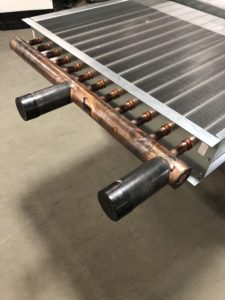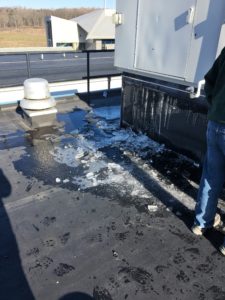
Of all of the various types of coils, steam coils operate in the most complicated ways. They are, in effect, a product of the system and controls around the coil. If not installed correctly, steam coils simply won’t work properly.
Overview:
The object of any steam coil is to have steam enter the coil as steam and exit as condensate. In a perfect scenario, the BTU load on the coil turns steam into condensate just before it’s ready to exit the coil. Under real world conditions however, condensate usually begins to form inside the tubes almost immediately. Especially when dealing with low-pressure systems, you have to find a way to evacuate the condensate from the steam coil.
Coil Pitch:
A good coil manufacturer will internally pitch the steam coil within the coil casing to force the condensate toward the outlet connection. This pitch is usually 1/8 “ per lineal foot of coil.
Coil Length:
If you require steam to travel 144” and make multiple passes through the coil, then, simply put, your system will not work properly. Condensate forms too early, and it cannot escape the coil. Because of this, coils cannot be too long. A better strategy is to break one long coil into two smaller coils side by side, while feeding from both sides.
Tube Diameter:
Steam Distributing coils often have to be 1 1/8 ” diameter tubes. If the BTU load on a coil is really large, then as a result, you will generate many more Lbs./hour of condensate. If the tube diameter is too small, then the condensate, which needs to evacuate, has no place to go.
Traps:
Traps are required on steam coil systems. The traps should be “float & thermostatic” type traps and be located 18 “ below the condensate connection on the steam coil. Without this, the condensate just sits in the system without any place to go.
Vacuum Breakers:
Vacuum Breakers are often installed in coil systems to remove any excess condensate that may remain within the coil.
Insulated Piping:
There is no such thing as a “Condensate” Heating coil, built as a steam coil. IT DOESN’T WORK. However, and this happens an astounding amount of times, due to the long distances the steam has to travel from the boiler to the coil, many times, the steam will enter the coil as condensate due to the piping not being insulated.
Anything that makes condensate lay in a coil is harmful to both the steam coil and the system. You will get a “water hammer” when the system is turned on and the incoming steam just blasts against the condensate. Worse than the loud and annoying sound that produces is the fact that it just destroys the steam coil. The brazing was never designed for “water hammer”. Also, the coils do not heat properly. Have you ever seen a long coil and run your hand down its length only to feel that the entering steam end of the coil is hot but the far end is cold? More times than not, this means that condensate is laying in the coil and not allowing the steam to properly travel the length of the coil.
Steam Coils require a real expertise to design & build. We at Capital Coil have a long history in solving coil problems and building steam coils so that they work correctly the first time. Give us a call for your next job – you’ll be pleasantly surprised!
RELATED POSTS
Different Types of Steam Coils?

